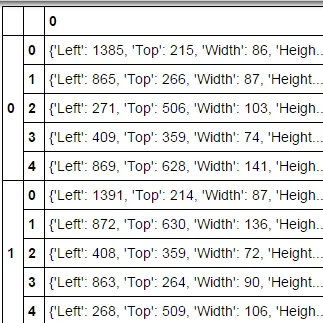我有一种数据结构,它是一个字典列表的列表:
[
[{'Height': 86, 'Left': 1385, 'Top': 215, 'Width': 86},
{'Height': 87, 'Left': 865, 'Top': 266, 'Width': 87},
{'Height': 103, 'Left': 271, 'Top': 506, 'Width': 103}],
...
]
我可以将其转换为数据框架:
detections[0:1]
df = pd.DataFrame(detections)
pd.DataFrame(df.apply(pd.Series).stack())
这将产生:
这几乎是我想要的,但是:
我如何将每个单元格中的字典转换为具有列“Left”、“Top”、“Width”、“Height”的行?
